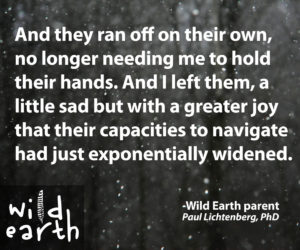Something about that developmental moment, when nature, language, and expansion come together. My sons Teo and Sebastian, 4 and 3, respectively, were helping me fill up the wheelbarrow with wood for the fire, on a path I made through the woods out by the pond at ‘Iris.’ As we were filling up the wheelbarrow, I looked out towards our neighbor’s huge field, beyond the long stone wall that separates our properties.
The woods that developmentally, were once woods, were now a dream world of imagination, a wider expanse from the small confines of last year’s sandbox.
There were some felled trees that somehow looked like ships floating out in a winter sea. And one old, rotted one, the bare root mass of which looked like a fairie house, and another, rotted in such a way as to look like a sea creature, an old whale with her mouth open. She had eyes on the sides and a spout on top. This was my opportunity.
The wheelbarrow was just about full, and I said, “Hey boys, look! Out there in the sea!” That was the moment I’ve been waiting for. The woods that developmentally, were once woods, were now a dream world of imagination, a wider expanse from the small confines of last year’s sandbox. The playground was now the entire woods and fields beyond.
And they ran off on their own, no longer needing me to hold their hands. And I left them, a little sad but with a greater joy that their capacities to navigate had just exponentially widened. And with the new explorations of new territory, one of which is the natural world that they will soon be custodians and need to nourish, understand, care for, and sustain, a deepened interior landscape is also being cultivated. There is no separation between these worlds. Each will call forth the other to ensure well-being, compassion, and respect for all beings sharing their world.
 I left them for quite a while, as I loaded the cut wood onto the woodpile by the house a distance from where they were playing. I found myself occasionally looking up or listening to their laughter echoing through the woods, like birds calling.
I left them for quite a while, as I loaded the cut wood onto the woodpile by the house a distance from where they were playing. I found myself occasionally looking up or listening to their laughter echoing through the woods, like birds calling.
I went into the house to the dining room window that overlooks the pond and woods and just watched with an awe that brought tears. They were still riding the whale and feeding her small pieces of wood. How this play transforms into the larger play of life is what we call development.
Staying connected to nature is staying connected to our bodies, which is staying connected to our emotional landscapes, the field in which empathy and love blossom into intimacy; that space embodying all spaces that require the caring and understanding we all need to keep life living and whole.
 Paul Lichtenberg, PhD, Wild Earth Parent
Paul Lichtenberg, PhD, Wild Earth ParentPaul Lichtenberg, PhD is a Buddhistically-inspired relational psychoanalytic therapist in private practice in Manhattan, and co-founder with his wife, Sibylle of `Iris,’ a yoga retreat center in Accord, NY. Next spring and summer, Paul and Sibylle will be introducing permaculture design and practice at Iris. More about Paul's work.
Comments are closed.
Love! I especially appreciate your description of development as it relates to nature and our bodies.
Beautiful Paul. You perfectly describe that first moment of watching your child play in nature. It tugs a little on the heart because they are playing out of arms reach and ‘learning to fly’. But it brings so much joy knowing they are comfortable being at one with nature. That’s a testament to the foundation you helped create in them.
Thanks so much for sharing this beautiful story, Paul. Today, my youngest boy, Asher (now age 14), packed himself hot tea, a grilled cheese sandwich, a sharp knife and tinder bundle and headed into the woods, on his own, and out of sight. There, he made and tended a fire, practiced carving and primitive skills (he is getting ready to become a C.I.T. at Wild Earth this summer), and enjoyed the quiet, deep connection with the stream and trees in the woods behind our home. Asher’s older brother, Kole, and I joined him after a few hours. Such a special day for me.